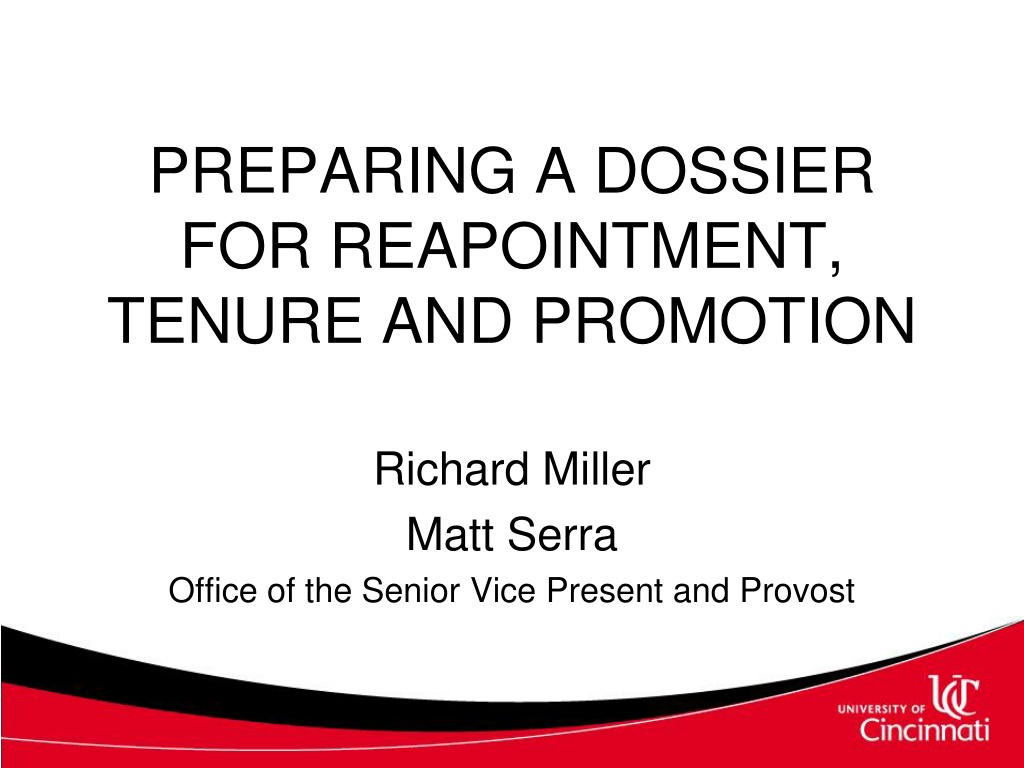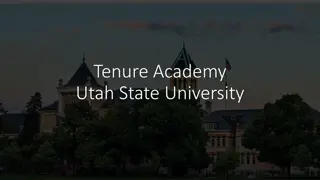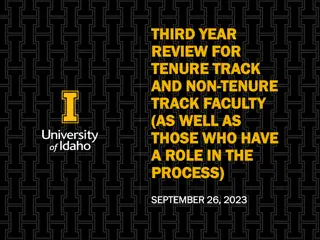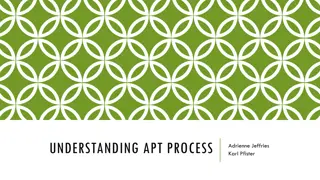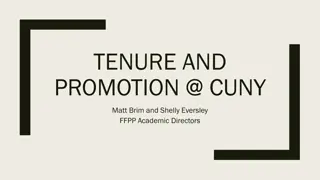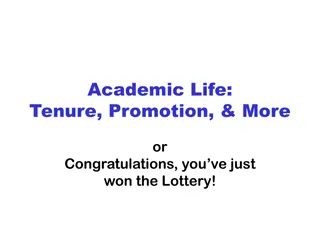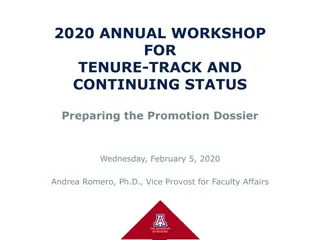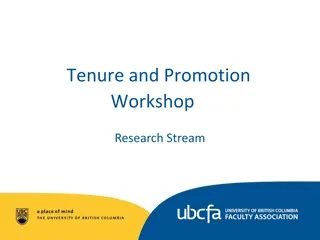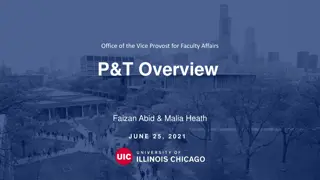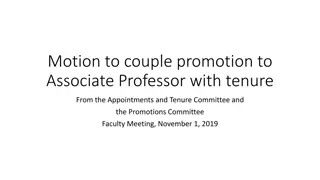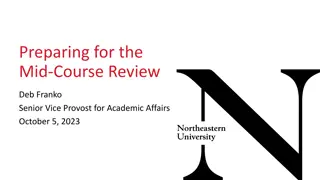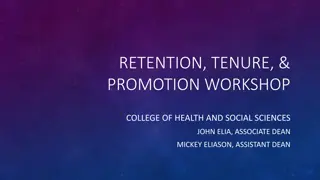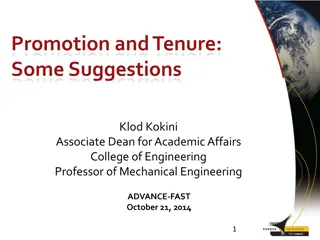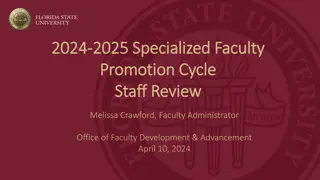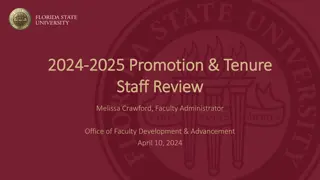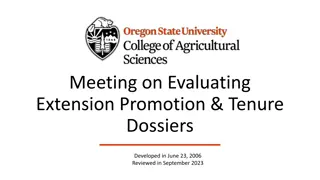Tenure and Promotion Process
Tenure is a form of for-cause employment in academia where faculty can face termination under specific conditions. It's not a guarantee of lifelong job security, but entitles faculty to due process. Titles and academic units play crucial roles in the reappointment, promotion, and tenure processes.
Download Presentation

Please find below an Image/Link to download the presentation.
The content on the website is provided AS IS for your information and personal use only. It may not be sold, licensed, or shared on other websites without obtaining consent from the author.If you encounter any issues during the download, it is possible that the publisher has removed the file from their server.
You are allowed to download the files provided on this website for personal or commercial use, subject to the condition that they are used lawfully. All files are the property of their respective owners.
The content on the website is provided AS IS for your information and personal use only. It may not be sold, licensed, or shared on other websites without obtaining consent from the author.
E N D
Presentation Transcript
PREPARING A DOSSIER FOR REAPOINTMENT, TENURE AND PROMOTION Richard Miller Matt Serra Office of the Senior Vice Present and Provost
Lets get the technical stuff out of the way first. What IS tenure????
There are two types of employment: At Will you can be terminated for any legally allowable reason or for no reason at all. Most people are employed at will. For Cause (or Contractual) Employment you can only be terminated for specified reasons. Tenure is for cause employment.
Tenure is NOT a guarantee of life time employment!!!!!! Faculty can be terminated for: 1) Serious violations of University Rules or Laws (which may have other consequences). 2) Failing to perform their stated duties in a satisfactory manner. 3) Serious budgetary issues. 4) Program/Degree elimination.
However, tenured faculty are entitled to due process prior to termination. At UC, this is covered by the Collective Bargaining Agreement (CBA).
TITLES Unqualified Have no qualifier Tenure track Qualified Have a qualifier such as research , educator , practice , clinical and affiliate . Not tenure track
TITLES Title information is found: University Rules 50-3-03; 50-15-02 and 03. In Article 6 of the CBA Your title is VERY important. Specifics of the reappointment, promotion and tenure process are tied to your title.
TWO REALLY IMPORTANT DEFINITIONS! Academic Unit = The smallest academic unit you belong to. Usually a department, but it could be a college, library jurisdiction, or other type of unit. Unit Criteria the Reappointment, Promotion and Tenure (RPT) Criteria of your unit.
THE BASICS TENURE TRACK You get an initial appointment. About 18 months before the end of the initial appointment, you go through reappointment. You can be reappointed for 3, 2 or 1 year or not be reappointed. If you are reappointed, the process repeats until the end of the probationary period. Prior to the end of the probationary period, you apply for tenure. Tenure is an up or out process.
Probationary Periods TITLE Assistant Professor Associate Professor Assistant or Associate Librarian Senior Associate Librarian Instructor/Beginning Librarian TERM 7 years 5 or 6 years 7 years 5 or 6 years Cannot be tenured at this rank. Must be promoted prior to tenure. Time in this rank counts toward probationary period of the higher rank. Initial appointment and probationary periods are in Article 6 of the CBA!
THE BASICS NON-TENURE TRACK You get an initial appointment. About 18 months before the end of the initial appointment, you go through reappointment. You can be reappointed for 1 to 5 years (based on Unit Criteria) or not be reappointed. If you are reappointed, the process repeats 18 months before the appointment expires. Faculty with qualified titles who have been here at least 7 years may have an expedited review.
THE BASICS NON-TENURE TRACK Reappointment of faculty with qualified titles is subject to program need. Reappointment of research faculty is usually tied to the ability to obtain sufficient funding to support a research program and some percentage of the faculty member s salary. The initial appointment letter will spell this out. Faculty with qualified titles may not be required to meet the RPT standards in all 3 areas of teaching, scholarship and service. Depends on the title and is spelled out in initial appointment letter or the unit RPT criteria.
THE PROCESS Your unit RPT Committee reviews the dossier and makes a recommendation. Your Unit Head reviews the reviews the dossier and makes a recommendation. Your College RPT Committee reviews the dossier and makes a recommendation. Your Dean reviews the dossier and makes a recommendation. The Provost reviews the dossier and makes a recommendation for tenure or promotion to Professor or Senior Librarian to the Board. The Provost grants reappointment or other promotions.
THE MOST IMPORTANT RULES CBA 7.3.2 Academic recommendations at all levels of review shall be based on (the Unit s) approved RPT Criteria CBA 7.5.6 The recommendation from the Academic Unit RPT Committee shall be given serious consideration, and no committee or administrator shall make a different recommendation except for substantial reasons stated in writing.
Reappointment, promotion or tenure are granted only if you meet the stated RPT criteria of your unit.
The dossier is the proof that you have met this criteria!!!
ANOTHER IMPORTANT RULE According to the CBA, the ONLY material any committee or administrator is allowed to consider is what is in the dossier. If something is NOT there, it cannot be considered.
WHO CAN PUT THINGS IN THE DOSSIER? You at any time. Updating your dossier when something happens (a thank you letter from a student, a paper published, you get a grant, etc.) is a good idea. A RPT committee or an administrator. You must be copied You may respond
TYPICAL SCHEDULE Assistant Professor Appointment Starts Dossier Due1 Appointment Ends Initial Appointment August 15, 2014 First Reappointment Second Reappointment Tenure February 15, 2016 August 14, 2017 February 15, 2018 August 14, 2019 August 15, 2017 August 15, 2019 N/A August 14, 2021 October 15, 20202 Never if you are successful! 1 This assumes no change to the CBA. COM had different deadlines, see Article 7 of the CBA. Colleges may establish earlier dates with proper notice. 2 Early tenure and promotion applications are allowed. See Article 7 of the CBA and your Unit Criteria.
WHEN SHOULD YOU START ASSEMBLING YOUR DOSSIER? NOW!!!
Now is the time to start collecting things for you dossier! You can always leave something out, but you cannot add something you do not have!!!!
A SUCCESSFUL DOSSIER TAKES PLANNING! YOU NEED TO THINK ABOUT WHAT YOU MAY NEED SO YOU HAVE IT!
TEACHING (What you need at a minimum) Student evaluations for EVERY course with comments. A reflection on each class and what you can improve. Any other feedback (peer review, letters from students, awards, etc.) Examples of course creation, improvement and/or innovation.
SCHOLARSHIP (What you need at a minimum) Copies of things published since you joined UC even if they are based on work before you got here. Copies of proposals even those not funded. Keep any comments, too. Information about or copies of presentations, showings, recitals, exhibits, etc. Examples of any impact of the work patents, products, policy changes, awards, etc.
SERVICE (AT A MINIMUM) Lists of Committee service Unit, College, University, Professional, Community. Special projects Special assignments (e.g. accreditation) Keep track of time spent and contributions. Good record keeping is essential. You will not remember three years from now how much time you spent on a committee this semester!
REAPPOINTMENT-TENURE TRACK Each unit has its own criteria, but most units reappointment criteria can be summed up as: Given where you are in the probationary period, is what you have done so far in teaching, scholarship and service consistent with a trajectory that suggests that you have a reasonable chance to meet the tenure and promotion criteria at the end of the probationary period?
REAPPOINTMENT For non-tenure track faculty: Reappointment is based on achieving specific goals set forth in the Unit RPT Criteria.
READING THE CRITERIA IS IMPORTANT! It is important to meet the stated criteria! Examples: It is expected the successful candidate will publish an average of 1.5 to 2 papers in refereed journals per year. The candidate must have a book published or at the publisher and needing only minor changes. The publisher must be a reputable publisher of scholarly materials. The candidate is expected to, on average, fund 50% of his/her salary from research grants. If they say it, they mean it!!!!!
IF ONLY IT WERE THAT EASY . Some criteria is pretty nebulous: The candidate shall exhibit excellent teaching. What EXACTLY does that mean??
ASK YOUR UNIT HEAD As soon as practical, meet with your Unit Head. Go over the criteria. Ask for clarifications. Ask for examples of success. Ask about interpretations Schedule a meeting with the RPT chair or committee and ask the same questions.
DEANS ARE SCARY BUT Actually, Deans are not really scary, but it can be intimidating. However, you should meet with your Dean to get an idea of how your Dean would interpret the criteria.
What you are trying to determine is the usual interpretation of the criteria. Example one unit criteria says publications showing excellence in research but the unit committee stated they interpret this as 1.5 2 publications/year.
SO WHAT ARE WE LOOKING FOR?? Do you meet the criteria? Is the performance good in an absolute sense? Are there signs of progress and growth? Is there evidence of both independence and collaboration? If applicable to your title, are you building a consistent and excellent scholarship program that contributes to the field? Do you have a good relationship with students?
QUALITY MOST OF ALL We are looking for quality over quantity. In general, it is better to have fewer things of high quality. But quantity is important too!!!
WHAT TO PUT IN THE DOSSIER Initial letter of appointment. Tells us where you in the probationary period Your title/status (e.g. unqualified vs. qualified) Any special conditions of offer (e.g. reduced course loads, need to fund % of salary). Modifications/exemptions from criteria (e.g. Educator series are usually exempt from scholarship requirements).
WHAT TO PUT IN THE DOSSIER Subsequent letters of reappointment Tells us when your appointment ends. Summarizes previous evaluations. Helps us judge if you addressed previous areas of concern. Annual performance reviews Charts your progress.
WHAT TO PUT IN-TEACHING All student and peer evaluations Evidence of course creation/improvement Evidence of student learning e.g. My students performed above average on block exams. Awards, letters from students, other evidence of excellence. Evidence of training (such as CET&L courses) Scholarship in teaching and learning (grants, papers, presentations).
WHAT TO PUT IN- SCHOLARSHIP Papers, books, reviews, or other evidence of written scholarship. Separate reviewed and non-reviewed Separate journal from conference Include any evidence of impact Include reviews if available Evidence of presentations, recitals, showings, etc. Include reviews if available.
WHAT TO PUT IN - SCHOLARSHIP Proposals funded and not funded Indicate your involvement Include reviews if available Separate internal/external. Separate competitive from non-competitive Include evidence of level of competition if available Information on funded grants Indicate your involvement
WHAT TO INCLUDE TEACHING & SCHOLARSHIP Evidence of undergraduate advising Advising of MS and PhD students Include information about publications, presentations or other works with students. Any other significant mentoring Study abroad Special studies Graduate committee service.
WHAT TO PUT IN -SERVICE Describe service activities. Describe how this contributes to your overall growth as a faculty member. Describe how the University benefits at any level. This is the least important category for new tenure track faculty.
SINS OF OMISSION Don t leave out bad reviews We will ask for them anyway. Use these to demonstrate improvement. Provide all facts about papers, grants and service. Don t conveniently leave out information that would show you have limited participation. Be honest about what you contribute.
We know new professors sometimes get off to a rough start we look for improvement. We know what constitutes quality. We have seen people inflate their records. We have seen people flat out lie. Be honest it is your best bet.
WHEN WE DISAGREE The CBA says the Unit Decision is given serious consideration . If an upper level of review disagrees and gives a different decision (positive or negative), they MUST state the reason. It must be based on substantial reasons and their interpretation of the Unit Criteria.
NEGATIVE DECISIONS You have the right to dispute negative decisions within 14 days of the first negative decision. You have the right to add things to the dossier which may impact the decision.
GRIEVANCE If you are denied reappointment, promotion or tenure, you can grieve: Violation of academic freedom. If the Unit RPT criteria were not followed. If there was an error in process. You cannot grieve judgments. Grievance can get you a new review. RPT is never granted for error.
BUT HERE IS THE GOOD NEWS Most Faculty members are of very high quality and do JUST FINE. In fact reviewing RPT files is very encouraging. Seeing how well faculty member are doing shows the over all excellence of our faculty.
RESOURCES - PEOPLE Your Unit Head and Unit RPT Committee. Senior Faculty. Your College RPT Committee and Dean. AAUP (if represented). Vice Provost for Academic Personnel.
RESOURCES - WRITTEN Unit RPT Criteria The Collective Bargaining Agreement (on- line) University Rules (on-line) Know the rules! Ignorantia legis neminem excusat!
